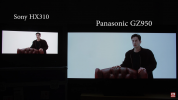Black is just one of the more than a billion shades of color that today's television can produce. So black and pure white are the extremes of these color shades. So this black to white contrast is important but it's not the only contrast that matters. How the TV produces other colors, different shades and contrast between them is equally important. And for a great majority of content(more than 95%) is not black but have high APL where QLED shines with it brightness and color volume. OLED can't maintain color volume at high level of brightness and uses too much of it's white sub pixel to boost it's brightness which leads to bluish tint. What every TV suffers is from screen uniformity where OLED has a better record than LEDs and generally there is less of panel lottery in OLED. And for contrast anything above 10000-15000 is good enough for majority of contents except for end credits which anyway no one watches

or for movies with lot of starfield scenes which is also a niche. Blooming is another topic, Samsung and other QLED may show blooming because of high specular highlight brightness, way more than OLED, if you bring the brightness down the blooming is reduced significantly. Moreover blooming is also part responsible because of how our eyes perceive extremely bright objects against dark background from short distance and in that case even Samsung brighter OLED with 1200nits looks like having blooming not because it's actually there but because of how our eyes perceives light.
Look at the below pictures, no OLED can survive this, look how dull the entire scene looks compared to an LCD with just around 700-1000 nits not even 900 nits odd that TV's like Samsung Q90A or Hisense U8 can do for such APL scenes. So, it better not to flame fanboy wars.










